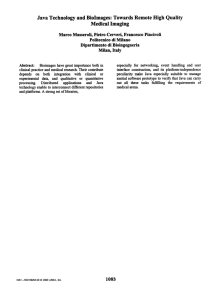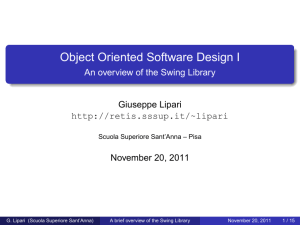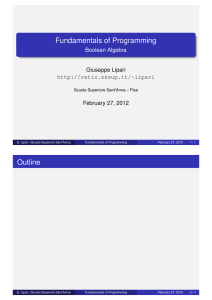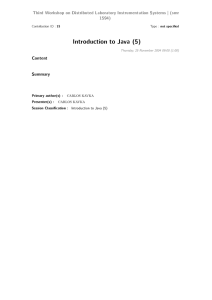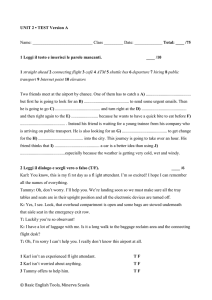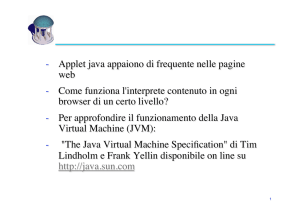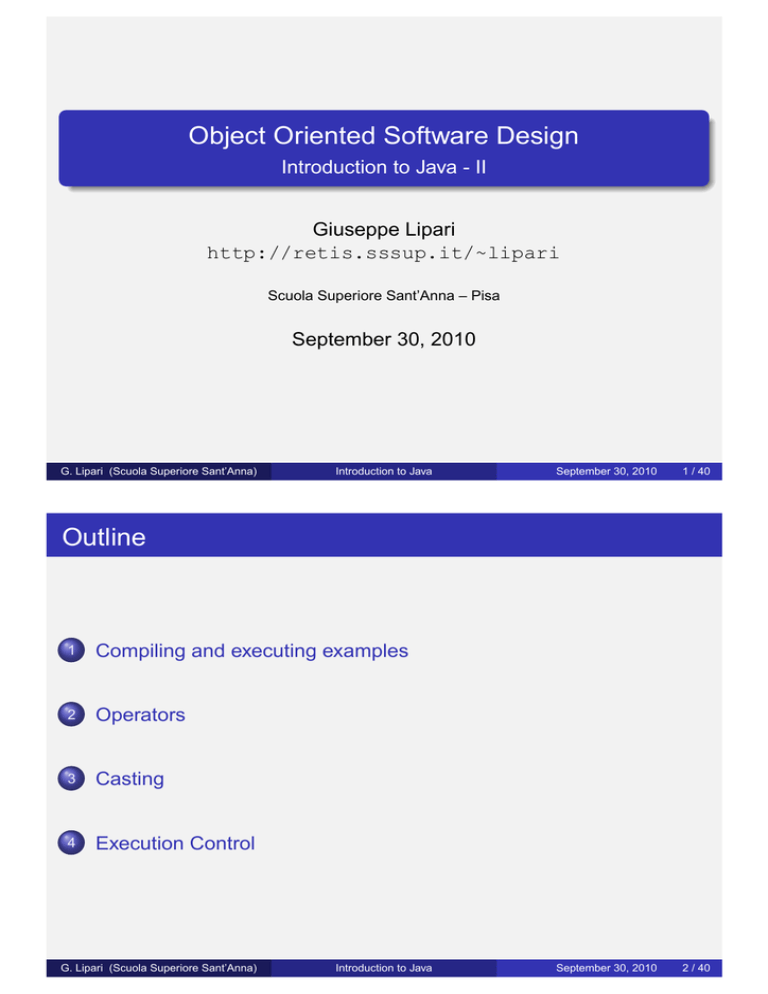
Object Oriented Software Design
Introduction to Java - II
Giuseppe Lipari
http://retis.sssup.it/~lipari
Scuola Superiore Sant’Anna – Pisa
September 30, 2010
G. Lipari (Scuola Superiore Sant’Anna)
Introduction to Java
September 30, 2010
1 / 40
September 30, 2010
2 / 40
Outline
1
Compiling and executing examples
2
Operators
3
Casting
4
Execution Control
G. Lipari (Scuola Superiore Sant’Anna)
Introduction to Java
Makefile
All examples in these slides are included in directories
material/examples/<lecture_name>
To compile them, all you have to do is to enter the directory with a
terminal, and type make
This will execute the make command which interprets file
makefile
The file contains instructions on how to compile and execute the
programs
To execute a program, type make <ProgramName>
G. Lipari (Scuola Superiore Sant’Anna)
Introduction to Java
September 30, 2010
4 / 40
Bruce Eckel examples
Some of the examples are taken by Bruce Eckel’s “Thinking in
Java”
These examples use utility classes that can be found in directory
com/bruceeckel/
So, you will need this directory to compile and execute Bruce
Eckel’s examples
How to install examples and slides:
Download from my web site http://retis.sssup.it/~lipari
the two zip files material.zip and bruceeckel.zip
unzip them in the same directory
Now you are ready to compile and execute the code
G. Lipari (Scuola Superiore Sant’Anna)
Introduction to Java
September 30, 2010
5 / 40
Testing
In some of the examples, Bruce Eckel uses a Test class to check
the correctness of the example
The Test class compares the output of the program with the
expected output
If they are the same, the program is correct
If they differ, the program is interrupted with an error code
We will see in a while how it works
G. Lipari (Scuola Superiore Sant’Anna)
Introduction to Java
September 30, 2010
6 / 40
Operators in J AVA
An operator takes one or more arguments and produces a new
value. The arguments are in a different form than ordinary method
calls, but the effect is the same
Addition (+), subtraction and unary minus (-), multiplication (*),
division (/), and assignment (=) all work much the same in any
programming language
Almost all operators work only with primitives (cannot be used on
references)
Exceptions are ’=’, ’==’ and ’!=’, which work with all objects (and
are a point of confusion for objects).
In addition, the String class supports ’+’ and ’+=’.
G. Lipari (Scuola Superiore Sant’Anna)
Introduction to Java
September 30, 2010
8 / 40
Precedence
Operator precedence defines how an expression evaluates when
several operators are present
J AVA has specific rules that determine the order of evaluation
Programmers often forget the other precedence rules, so you
should use parentheses to make the order of evaluation explicit.
Example:
a = x + y - 2/2 + z;
a = x + (y - 2)/(2 + z);
G. Lipari (Scuola Superiore Sant’Anna)
Introduction to Java
September 30, 2010
9 / 40
Assignment
Assignment is performed with the operator =
It means “take the value of the right-hand side (often called the
rvalue) and copy it into the left-hand side (often called the lvalue).”
An rvalue is any constant, variable, or expression that can produce
a value,
an lvalue must be a distinct, named variable.
Assignment of primitives is quite straightforward
For example, if you say a = b for primitives, then the contents of b
are copied into a
If you then go on to modify a, b is naturally unaffected by this
modification
G. Lipari (Scuola Superiore Sant’Anna)
Introduction to Java
September 30, 2010
10 / 40
Assignment of objects
Whenever you manipulate an object, what you’re manipulating is
the reference
if you say c = d for objects, you end up with both c and d
referencing the object that, originally, only d pointed to
Example:
./examples/04.java-examples/Assignment.java
G. Lipari (Scuola Superiore Sant’Anna)
Introduction to Java
September 30, 2010
11 / 40
Aliasing
This phenomenon is often called aliasing, and it’s a fundamental
way that Java works with objects.
But what if you don’t want aliasing to occur in this case?
You have to copy members one by one
Aliasing happens also when passing objects to methods
In other languages, we would say that an object is passed by
reference, instead of passing it by value (in C++ it is possible to
choose)
In J AVA, all you manage is a reference, so you pass references by
value (and objects by reference)
Example:
./examples/04.java-examples/PassObject.java
G. Lipari (Scuola Superiore Sant’Anna)
Introduction to Java
September 30, 2010
12 / 40
Mathematical Operators
An example is here:
./examples/04.java-examples/MathOps.java
Notice the use of the regular expressions to check the correctness
of the output:
"-?\\d+" means a number that may be preceded by a minus sign
("-?") and may have an arbitrary number of digits ("\\d+")
"%%" means that the string is actually a regular expression
G. Lipari (Scuola Superiore Sant’Anna)
Introduction to Java
September 30, 2010
13 / 40
Increment/Decrement
Something you will need to do very often is to
increment/decrement integer variables
For example, for implementing cycles
As in C, you can simply use pre- and post- increment/decrement
operators ++ and -With pre-increment, the result of the expression is the value of the
variable after the increment (as in ++i)
With post-increment, the result of the expression is the value of the
variable before it is incremented
Example: ./examples/04.java-examples/AutoInc.java
Pay attention to the difference between pre- and post- increment!
G. Lipari (Scuola Superiore Sant’Anna)
Introduction to Java
September 30, 2010
14 / 40
Comparison
Often, you may want to compare things for equality
Relational operators (<,>, ==, <=, >=, !=), returns a
boolean
They can be used for primitive types, with their obvious meaning
Operators ==, != also work with reference,
WARNING: they test equality of references!
Example:
./examples/04.java-examples/Equivalence.java
G. Lipari (Scuola Superiore Sant’Anna)
Introduction to Java
September 30, 2010
15 / 40
Equality of objects
What if I want to test equality of objects?
You have to use method equals()
All classes implicitely derive from a single standard class called
Object, for which this method is defined
All classes inherit such a method, thus you can call equals() on
every class
By default, equals() compares references (as ==)
However, many classes redefine (override) the method to
implement a different behavior (for example, Integer reimplement
equals to compare the content of the objects)
G. Lipari (Scuola Superiore Sant’Anna)
Introduction to Java
September 30, 2010
16 / 40
Example of equals()
An example of equals() for Integer
./examples/04.java-examples/EqualsMethod.java
An example of equals() for a user defined class
./examples/04.java-examples/EqualsMethod2.java
Here the behaviour is the same as ==
G. Lipari (Scuola Superiore Sant’Anna)
Introduction to Java
September 30, 2010
17 / 40
Logical Operators
Logical operators take boolean values and return a boolean
&&, ||, !
Unlike C and C++, logical operators cannot be applied to
non-boolean values
See ./examples/04.java-examples/Bool.java
G. Lipari (Scuola Superiore Sant’Anna)
Introduction to Java
September 30, 2010
18 / 40
Side effects
A boolean expression will be evaluated only until the truth or
falsehood of the entire expression can be unambiguously
determined
As a result, the latter parts of a logical expression might not be
evaluated
./examples/04.java-examples/ShortCircuit.java
Pay attention to side-effects of expressions!
G. Lipari (Scuola Superiore Sant’Anna)
Introduction to Java
September 30, 2010
19 / 40
Bitwise and shift operators
The bitwise operators allow you to manipulate individual bits in an
integral primitive data type
&, |, ^ respectively and, or and xor
~ is the bitwise not (takes only one operand)
The shift operators allow to shift the binary representation of an
integer to the left (<<) or to the right (>>)
int i = -1;
i = i << 10;
i = i >>> 5;
// signed shift ten bits to the right
// unsigned shift 5 bits to the left
Example: ./examples/04.java-examples/URShift.java
They come from the fact that J AVA was used for embedded
systems
Not very much used, read the manual (or “Thinking in J AVA”) for
more information
G. Lipari (Scuola Superiore Sant’Anna)
Introduction to Java
September 30, 2010
20 / 40
Ternary if-else operator
This operator has the form:
boolean-exp ? exp0 : exp1
If the boolean expression is true, exp0 is evaluated, else exp1 is
evaluated
Of course, they must have the same type
An example is the following:
static int ternary(int i) {
return i < 10 ? i * 100 : i * 10;
}
The above code is equivalent to:
static int alternative(int i) {
if (i < 10) return i * 100;
else
return i * 10;
}
G. Lipari (Scuola Superiore Sant’Anna)
Introduction to Java
September 30, 2010
21 / 40
String + operator
The + operator in J AVA, when applied to Strings, concatenates
the two strings
In C++, it is possible to redefine (override or overload) the use of
any operator on any class
J AVA has not concept of overloaded operators, like in C++, this is
the only exception and it is built-in
The reason was to maintain simplicity
If one of the two operands is a String, the other is converted into a
String before being concatenated
int x = 0, y = 1, z = 2;
String sString = "x, y, z ";
System.out.println(sString + x + y + z);
G. Lipari (Scuola Superiore Sant’Anna)
Introduction to Java
September 30, 2010
22 / 40
Casting
The word cast is used in the sense of “casting into a mold.”
J AVA will automatically change one type of data into another when
appropriate (implicit casting)
For example, an int into a float (no loss of precision)
You can make casting explitic by using appropriate casting
operators
int i = 200;
long l = (long)i;
long l2 = (long)200;
(In both cases, the casting is superflous)
J AVA lets you cast every primitive type into every other primitive
type, except for boolean (which cannot be casted at all)
In some cases there will be loss of precision (truncation)
G. Lipari (Scuola Superiore Sant’Anna)
Introduction to Java
September 30, 2010
24 / 40
Various
Literals:
If you want to specify the type of a nuerical constant, you can put a
character after the number to specify the type: L stands for long, F
stands for float, and D stands for double,
Casting:
In general, the largest data type in an expression is the one that
determines the size of the result of that expression; if you multiply a
float and a double, the result will be double; if you add an int and a
long, the result will be long.
J AVA has no sizeof()
In C/C++, different data types might be different sizes on different
machines, so the programmer must find out how big those types
are when performing operations that are sensitive to size
J AVA programs are portable, hence there is no sizeof() operator
G. Lipari (Scuola Superiore Sant’Anna)
Introduction to Java
September 30, 2010
25 / 40
Overflow
J AVA does not check for overflow (it would be too heavy)
Pay attention to not overflow numerical values after an arithmetic
expression!
Example: ./examples/04.java-examples/Overflow.java
G. Lipari (Scuola Superiore Sant’Anna)
Introduction to Java
September 30, 2010
26 / 40
if-else
J AVA support all control flow statements of C/C++, except for goto
All conditional statements use the truth or falsehood of a
conditional expression to determine the execution path
the if-else is the most basic form of flow control
if(Boolean-expression)
statement
or
if(Boolean-expression)
statement
else
statement
statement can be a simple expression, a statement, or a block of
statements grouped by curly braces
G. Lipari (Scuola Superiore Sant’Anna)
Introduction to Java
September 30, 2010
28 / 40
Example
IfElse.java
public class IfElse {
static Test monitor = new Test();
static int test(int testval, int target) {
int result = 0;
if (testval > target)
result = +1;
else if (testval < target)
result = -1;
else
result = 0; // Match
return result;
}
public static void main(String[] args) {
System.out.println(test(10, 5));
System.out.println(test(5, 10));
System.out.println(test(5, 5));
G. Lipari (Scuola Superiore Sant’Anna)
Introduction to Java
September 30, 2010
29 / 40
While
To loop a number of times over a set of statements, you can use
the while statement:
while(Boolean-expression)
statement
Example:
While.java
public class While {
static Test monitor = new Test();
static public void main(String args[]) {
int i = 0;
while (i<5) {
System.out.println(i + ": " + (i*2));
i++;
}
Bruce’s Eckel example:
./examples/04.java-examples/WhileTest.java
G. Lipari (Scuola Superiore Sant’Anna)
Introduction to Java
September 30, 2010
30 / 40
do-while
The do-while is pretty similar to the while statement:
do
statement
while(Boolean-expression);
Remember:
the do-while statement always execute at least once
the while statement could never execute
G. Lipari (Scuola Superiore Sant’Anna)
Introduction to Java
September 30, 2010
31 / 40
for loop
A for loop performs initialization before the first iteration. Then it
performs conditional testing and, at the end of each iteration,
some form of “stepping.”
for(initialization; Boolean-expression; step)
statement
Any of the expressions initialization, Boolean-expression or step
can be empty
An infinite loop: for(;;);
It works like this:
The expression is tested before each iteration,
as soon as it evaluates to false, execution will continue at the line
following the for statement.
At the end of each loop, the step executes.
G. Lipari (Scuola Superiore Sant’Anna)
Introduction to Java
September 30, 2010
32 / 40
Example
ListCharacters.java
public class ListCharacters {
static Test monitor = new Test();
public static void main(String[] args) {
for(int i = 0; i < 128; i++)
if(Character.isLowerCase((char)i))
System.out.println("value: " + i +
" character: " + (char)i);
Note that the variable i is defined at the point where it is used,
inside the control expression of the for loop, rather than at the
beginning of the block denoted by the open curly brace.
The scope of i is the expression controlled by the for.
G. Lipari (Scuola Superiore Sant’Anna)
Introduction to Java
September 30, 2010
33 / 40
Comma operator
You can define multiple variables within a for statement, but they
must be of the same type
You can also put multiple statements separated by a comma
inside the step, or initialization parts
CommaOperator.java
public class CommaOperator {
static Test monitor = new Test();
public static void main(String[] args) {
for(int i = 1, j = i + 10; i < 5;
i++, j = i * 2) {
System.out.println("i= " + i + " j= " + j);
}
You can see that in both the initialization and step portions, the
statements are evaluated in sequential order. Also, the
initialization portion can have any number of definitions of one type
G. Lipari (Scuola Superiore Sant’Anna)
Introduction to Java
September 30, 2010
34 / 40
Break and Continue
break quits the loop without executing the rest of the statements
continue stops the execution of the current iteration and goes
back to the beginning of the loop to begin the next iteration
BreakAndContinue.java
public class BreakAndContinue {
public static void main(String[] args) {
for(int i = 0; i < 100; i++) {
if(i == 74) break; // Out of for loop
if(i % 9 != 0) continue; // Next iteration
System.out.println(i);
}
int i = 0;
// An "infinite loop":
while(true) {
i++;
int j = i * 27;
if(j == 1269) break; // Out of loop
if(i % 10 != 0) continue; // Top of loop
System.out.println(i);
}
G. Lipari (Scuola Superiore Sant’Anna)
Introduction to Java
September 30, 2010
35 / 40
Goto?
We said that J AVA has no goto statement
Actually, J AVA has labels that can be used in conjunction with
break and continue
A label is identified by a name followed by a colon:
mylabel:
The only place a label is useful in Java is right before an iteration
statement
It is used when you have multiple nested loops and you want to go
out from all of them at once
G. Lipari (Scuola Superiore Sant’Anna)
Introduction to Java
September 30, 2010
36 / 40
Label
Let’s see how it works
label1:
outer-iteration {
inner-iteration {
//...
break; // 1
//...
continue; // 2
//...
continue label1; // 3
//...
break label1; // 4
}
}
In case 1, the break breaks out of the inner iteration and you end
up in the outer iteration
In case 2, the continue moves back to the beginning of the inner
iteration
in case 3, the continue label1 breaks out of the inner iteration and
to Java
September 30, 2010
37 / 40
the outer iteration, all the Introduction
way back
to label1
G. Lipari (Scuola Superiore Sant’Anna)
Then it does in fact continue the iteration, but starting at the outer
iteration
Examples
In case 4, the break label1 also breaks all the way out to label1,
but it does not reenter the iteration.
Example with for loop:
./examples/04.java-examples/LabeledFor.java
Example with while loop:
./examples/04.java-examples/LabeledWhile.java
G. Lipari (Scuola Superiore Sant’Anna)
Introduction to Java
September 30, 2010
38 / 40
switch
The switch statement has the following form:
switch(integral-selector) {
case integral-value1 : statement;
case integral-value2 : statement;
case integral-value3 : statement;
case integral-value4 : statement;
case integral-value5 : statement;
// ...
default: statement;
}
break;
break;
break;
break;
break;
Each case ends with a break, which causes execution to jump to
the end of the switch body
This is the conventional way to build a switch statement, but the
break is optional.
If it is missing, the code for the following case statements execute
until a break is encountered
Example:
./examples/04.java-examples/VowelsAndConsonants.java
G. Lipari (Scuola Superiore Sant’Anna)
Introduction to Java
September 30, 2010
39 / 40
Exercises
Exercise
Write a program that generates 25 random int values. For each value,
use an if-else statement to classify it as greater than, less than, or equal
to a second randomly-generated value.
Exercise
Write a program that uses two nested for loops and the modulus operator (%) to detect and print prime numbers (integral numbers that are
not evenly divisible by any other numbers except for themselves and 1)
Test the correctness of the program on the first 10 primes using the Test
class
G. Lipari (Scuola Superiore Sant’Anna)
Introduction to Java
September 30, 2010
40 / 40

